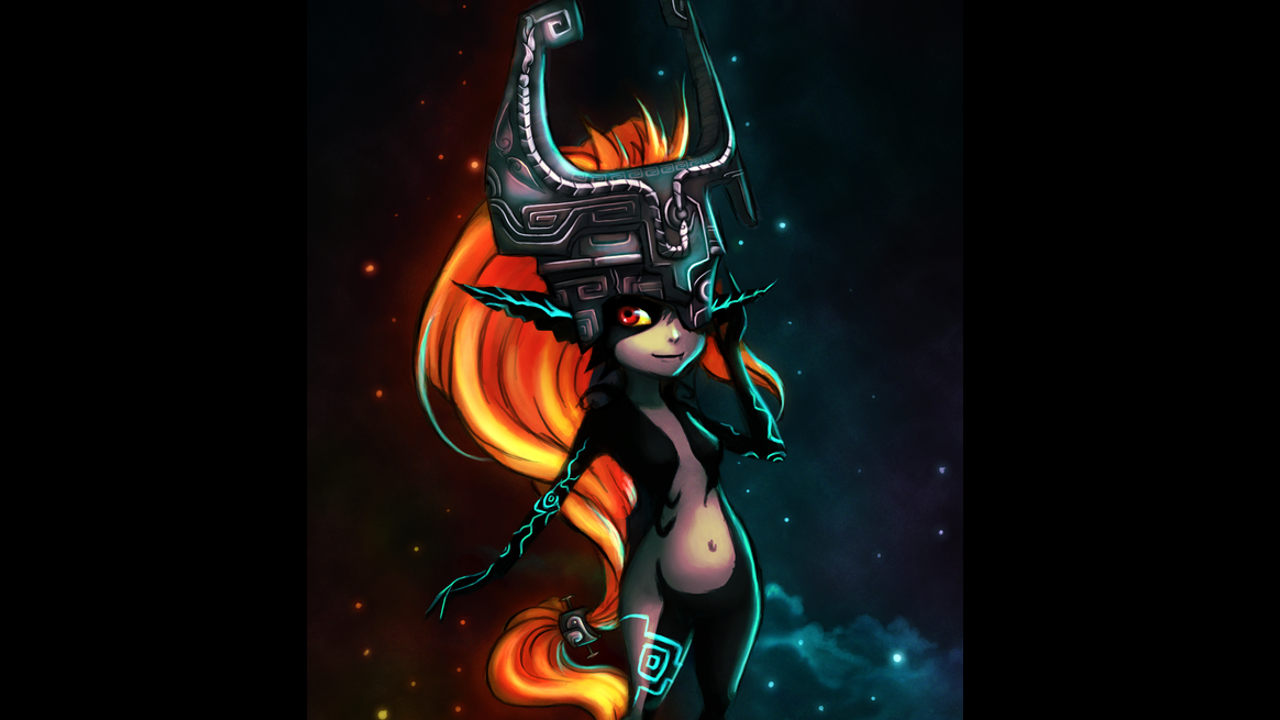The Dichotomy of Light and Dark is Symbolic of Midna
Posted on September 26 2018 by Michaela El-Ters

Midna stands out to me as one of the most well-written and interesting companion characters in the Zelda series because of how she grows and changes alongside the story. She’s not like Link’s previous companions — she’s selfish, sarcastic, and isn’t afraid to get her hands dirty in order to get what she wants. Her status as the titular Twilight Princess and the dichotomy of light and dark in the narrative coincides with her character development and the more kind, nurturing personality she displays later on.
I had an interesting experience with Twilight Princess, and by extension, Midna’s character development. When I was first introduced to the game, I watched my brother play the latter half following Midna’s change. I loved her kind-hearted personality and couldn’t wait to play the game myself. So when I booted it up and met a very snarky, mean-spirited version of the character I really liked, it left my twelve-year-old brain very confused and wondering what happened to her to cause such a dramatic change. Playing through the game helped me realize how natural her character arc unfolded through her experiences as well as the visual cues sprinkled throughout the story.
How the Thematic Contrast of Light & Dark Characterizes Midna
After the twilight has enveloped all of Hyrule is when Midna is arguably at her most cruelest. Link is simply a tool to her, a means to an end to save her kingdom from Zant’s rule. Right away, she makes it abundantly clear that she has no interest in what happens to the realm of light, Hyrule, and it’s indicative in the way she treats Link. From consistently disregarding his concern to rescue the friends from his village, talking down to him at every turn, and even yanking on his ears in his wolf form, she is insensitive to everyone around her. As Link begins dispelling the twilight and lessening its impact on Hyrule, her personality slowly begins to soften, but the major catalyst of change for Midna is when Princess Zelda sacrifices herself to save her.
 Midna’s exposure to genuine kindness and compassion from another princess fighting to save her realm, but in a different way that is less cruel and vindictive, changes her for the better. Once Hyrule is free from the grip of the twilight realm, she works together with Link to save her kingdom in the right way. It’s when the twilight is gone, and the light has returned, that Midna is at her kindest.
Midna’s exposure to genuine kindness and compassion from another princess fighting to save her realm, but in a different way that is less cruel and vindictive, changes her for the better. Once Hyrule is free from the grip of the twilight realm, she works together with Link to save her kingdom in the right way. It’s when the twilight is gone, and the light has returned, that Midna is at her kindest.
She apologizes to Link for the pain she’s caused and is physically kinder as well, leaning on his shoulder or stroking his cheek. For someone who was incredibly harsh and often lashed out at Link at the beginning of the game, the physical and emotional changes Midna exhibits coincide with her self-reflection and time spent in the realm of light. During the final battle against Ganondorf, she teleports Link and Zelda to safety before choosing to fight Ganondorf on her own, with the implications of her sacrifice being incredibly powerful and noble, contrasting the selfish individual she was when Link first met her in the depths of Hyrule Castle’s prison.
Why Midna’s Redemption Arc is Meaningful
 At the end of Twilight Princess, Zelda describes light and dark as “two sides of the same coin,” and this epitomizes Midna’s journey and how she changes. Metaphorically, the darkness is represented as Midna’s desperation and indifference to everyone else around her, while the light shows her transition into a loyal, kind companion that fights for the greater good. Midna’s journey from being selfish to selfless is paralleled by the shifting presence of darkness and light in the land of Hyrule, creating a deep narrative that is linked both visually and thematically.
At the end of Twilight Princess, Zelda describes light and dark as “two sides of the same coin,” and this epitomizes Midna’s journey and how she changes. Metaphorically, the darkness is represented as Midna’s desperation and indifference to everyone else around her, while the light shows her transition into a loyal, kind companion that fights for the greater good. Midna’s journey from being selfish to selfless is paralleled by the shifting presence of darkness and light in the land of Hyrule, creating a deep narrative that is linked both visually and thematically.
Midna, unlike many of the companion characters that precede her, is vital to the story, and it makes her character development more interesting and important as a result. When the story evolves and changes, so does she. The narrative mirrors her journey of self-discovery and kindness, elevating both the plot and her character development as a result. Her growth doesn’t negate her passionate spark either; she still retains moments of anger and sarcasm, building on who she is while exploring other sides of her personality. These qualities make her a balanced, humanized character because she doesn’t lose any of her personality traits along the way.
In some respect, it’s a shame that Nintendo hasn’t developed subsequent companion characters in the same way that they did with Midna. It’s clear that they learned from the success they had writing her arc, with the emphasis on strong, nuanced characters in Skyward Sword and Breath of the Wild, but I haven’t connected to a companion character as strongly as I have with Midna. I’m hoping that will change because, when it’s done right, the companions are amazing accompaniments to the world-building and story. Midna’s character arc helped me appreciate these emotional, personal journeys that can unfold alongside the story, and I would love to see more companion characters written with the same level of subtlety and depth.
It’s for all of these reasons that Midna is my favorite character, and she holds a special place in my heart as the first companion whose story I was genuinely interested in seeing unfold. Her strong personality and her character arc — conveyed through strong visuals and her actions — made her stand out during a time when the only exposure I had to companion characters were loud fairies and a talking boat. Twelve years later, Midna’s unique arc of redemption continues to be the highlight of both Twilight Princess and the Zelda series as a whole, and I doubt that will change any time soon.
Michaela El-Ters is a Senior Editor at Zelda Dungeon. For more of her analyses of video game characters and their arcs, check out her blog.
Feature art by Xenonia and karasuki

Michaela El-Ters is a Senior Editor for Zelda Dungeon. She is also an Senior Writer for Boss Rush Network, and writes blogs and streams games on Objection Network. Her favorite Zelda game changes with the seasons, but the series as a whole is near and dear to her heart.



